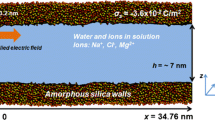Abstract
Porous anodic alumina has been of an increasing interest to applications of on-chip biosensors and bioseparations. However, the characteristics of molecular diffusion in alumina nanopores have not been fully explored. Here, we have investigated an ultra-thin freestanding alumina membrane fabricated on a silicon substrate as a new on-chip diffusion system. Sub-1,000 Da molecules such as caffeine were diffused through alumina pores with a pore diameter of 40 nm and a pore length of 1.2 μm. The diffusion dynamics was characterized by modeling the molecular transport as one-dimensional convective Fickian flow. The diffusion coefficients were calculated to be on the order of 10−8 cm2 s−1. The transport rate of coions was enhanced by increasing the ionic strength of diffusion solution. Relative to thick alumina membranes, the thin-film alumina was able to achieve a significantly higher flux rate, making it more favorable for rapid molecular transport. The characterizations we present here have contributed important experimental data to alumina nanofluidics, and are believed to be valuable for applications such as drug deliveries, molecular separations, and membrane biosensors.




Similar content being viewed by others
References
Bluhm EA, Bauer E, Chamberlin RM, Abney KD, Young JS, Jarvinen GD (1999) Surface effects on cation transport across porous alumina membranes. Langmuir 15:8668–8672
Bluhm EA, Schroeder NC, Bauer E, Fife JN, Chamberlin RM, Abney KD, Young JS, Jarvinen GD (2000) Surface effects on metal ion transport across porous alumina membranes 2. Trivalent cations: Am, Tb, Eu, and Fe. Langmuir 16:7056–7060
Bruus H (2005) Theoretical microfluidics, Department of Micro and Nanotechnology, Technical University of Denmark
Daiguji H, Yang PD, Majumdar A (2004) Ion transport in nanofluidic channels. Nano Lett 4:137–142
Dalvie SK, Baltus RE (1992) Transport studies with porous alumina membranes. J Memb Sci 71:247–255
Gong DW, Yadavalli V, Paulose M, Pishko M, Grimes CA (2003) Controlled molecular release using nanoporous alumina capsules. Biomed Microdevices 5:75–80
Hinds BJ, Chopra N, Rantell T, Andrews R, Gavalas V, Bachas LG (2004) Aligned multiwalled carbon nanotube membranes. Science 303:62–65
Hohlbein J, Steinhart M, Schiene-Fischer C, Benda A, Hof M, Hubner CG (2007) Confined diffusion in ordered nanoporous alumina membranes. Small 3:380–385
Jiang X, Mishra N, Turner JN, Spencer MG (2007) Freestanding alumina membrane by double-layer anodization. IEEE Trans Nanotechnol 6:328–333
Keller F, Hunter MS, Robinson DL (1953) Structural features of oxide coatings on aluminum. J Electrochem Soc 100:411–419
Kipke S, Schmid G (2004) Nanoporous alumina membranes as diffusion controlling systems. Adv Funct Mater 14:1184–1188
Kokonou M, Nassiopoulou AG, Giannakopoulos KP (2005) Ultra-thin porous anodic alumina films with self-ordered cylindrical vertical pores on a p-type silicon substrate. Nanotechnology 16:103–106
Lau KHA, Tan LS, Tamada K, Sander MS, Knoll W (2004) Highly sensitive detection of processes occurring inside nanoporous anodic alumina templates: a waveguide optical study. J Phys Chem B 108:10812–10818
Lee SB, Mitchell DT, Trofin L, Nevanen TK, Soderlund H, Martin CR (2002) Antibody-based bio-nanotube membranes for enantiomeric drug separations. Science 296:2198–2200
Li AP, Muller F, Birner A, Nielsch K, Gosele U (1998) Hexagonal pore arrays with a 50–420 nm interpore distance formed by self-organization in anodic alumina. J Appl Phys 84:6023–6026
Li J, Papadopoulos C, Xu JM, Moskovits M (1999) Highly-ordered carbon nanotube arrays for electronics applications. Appl Phys Lett 75:367–369
Masuda H, Fukuda K (1995) Ordered metal nanohole arrays made by a two-step replication of honeycomb structures of anodic alumina. Science 268:1466–1468
Metzger RM, Konovalov VV, Sun M, Xu T, Zangari G, Xu B, Benakli M, Doyle WD (2000) Magnetic nanowires in hexagonally ordered pores of alumina. IEEE Trans Magn 36:30–35
Niesner R, Heintz A (2000) Diffusion coefficients of aromatics in aqueous solution. J Chem Eng Data 45:1121–1124
Nishizawa M, Menon VP, Martin CR (1995) Metal nanotubule membranes with electrochemically switchable ion-transport selectivity. Science 268:700–702
Pfenniger M, Calzaferri G (2000) Intrazeolite diffusion kinetics of dye molecules in the nanochannels of zeolite l, monitored by energy transfer. Chemphyschem 1:211–217
Plecis A, Schoch RB, Renaud P (2005) Ionic transport phenomena in nanofluidics: experimental and theoretical study of the exclusion-enrichment effect on a chip. Nano Lett 5:1147–1155
Price WE (1989) Tracer caffeine diffusion in aqueous-solutions at 298K—the effect of caffeine self-association. J Chem Soc Faraday Trans 85:415–419
Sander M, Tan L (2003) Nanoparticle arrays on surfaces fabricated using anodic alumina films as templates. Adv Funct Mater 13:393–397
Sander MS, Prieto AL, Gronsky R, Sands T, Stacy AM (2002) Fabrication of high-density, high aspect ratio, large-area bismuth telluride nanowire arrays by electrodeposition into porous anodic alumina templates. Adv Mater 14:665–667
Schneider JJ, Engstler N, Budna KP, Teichert C, Franzka S (2005) Freestanding, highly flexible, large area, nanoporous alumina membranes with complete through-hole pore morphology. Eur J Inorg Chem 2005: 2352–2359
Takoh K, Takahashi A, Matsue T, Nishizawa M (2004) A porous membrane-based microelectroanalytical technique for evaluating locally stimulated culture cells. Anal Chim Acta 522:45–49
Toh CS, Kayes BM, Nemanick EJ, Lewis NS (2004) Fabrication of free-standing nanoscale alumina membranes with controllable pore aspect ratios. Nano Lett 4:767–770
Vlassiouk I, Krasnoslobodtsev A, Smirnov S, Germann M (2004) “Direct” detection and separation of DNA using nanoporous alumina filters. Langmuir 20:9913–9915
Vlassiouk I, Takmakov P, Smirnov S (2005) Sensing DNA hybridization via ionic conductance through a nanoporous electrode. Langmuir 21:4776–4778
Winkler BH, Baltus RE (2003) Modification of the surface characteristics of anodic alumina membranes using sol-gel precursor chemistry. J Memb Sci 226:75–84
Wolfrum B, Mourzina Y, Sommerhage F, Offenhausser A (2006) Suspended nanoporous membranes as interfaces for neuronal biohybrid systems. Nano Lett 6:453–457
Acknowledgments
The authors would like to thank Cornell NanoScale Science and Technology Facility (CNF) (Project 131005), and Nanobiotechnology Center (NBTC) (Contract ECS−9876771) at Cornell University for their support in the nanofabrication and the experiments in the chemical laboratory.
Author information
Authors and Affiliations
Corresponding author
Rights and permissions
About this article
Cite this article
Jiang, X., Mishra, N., Turner, J.N. et al. Diffusivity of sub-1,000 Da molecules in 40 nm silicon-based alumina pores. Microfluid Nanofluid 5, 695–701 (2008). https://doi.org/10.1007/s10404-008-0300-x
Received:
Accepted:
Published:
Issue Date:
DOI: https://doi.org/10.1007/s10404-008-0300-x




